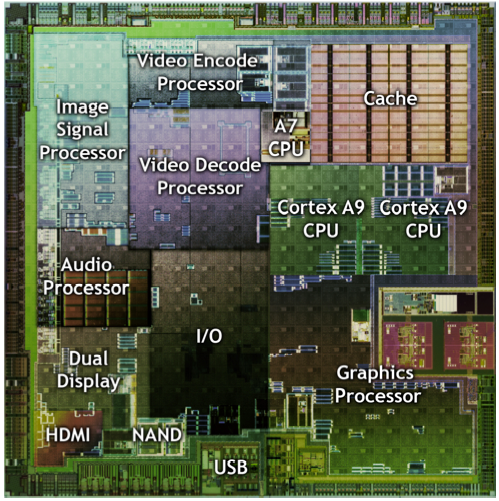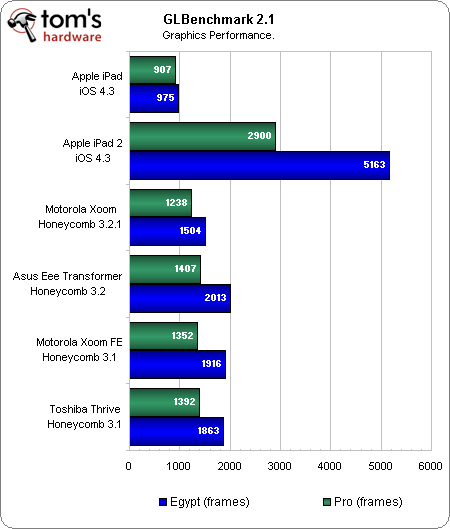Motorola's Xoom Family Edition Review: Not Just For The Kids
GPU Performance: Tegra 2
As we’ve mentioned in the past, mobile devices like smartphones and tablets use highly integrated logic referred to as SoCs to minimize physical footprints and power consumption, all the while optimizing for performance and functionality. By putting execution resource, graphics processing, system memory, and several other subsystems in a single ASIC, data transfers can be achieved more efficiently without soldering a bunch of separate chips onto a PCB. Incidentally, the same SoC term applies to modern desktop processors like Intel's Sandy Bridge- and AMD's Bulldozer-based chips, which combine cores, cache, memory controllers, and other capabilities.
| SoC | Apple A4 (iPad) | Apple A5 | Nvidia Tegra 2 |
|---|---|---|---|
| Tablets | Apple iPad | Apple iPad 2 | Acer Iconia Tab A500Asus Eee Pad TransformerMotorola XoomMotorola Xoom Family EditionSamsung Galaxy Tab 10.1Toshiba Thrive |
| Processor | 1 GHz ARM Cortex-A8 (single-core) | 1 GHz ARM Cortex-A9 (dual-core) | 1 GHz ARM Cortex-A9 (dual-core) |
| Memory | 256 MB 333 MHz LP-DDR (single-channel) | 512 MB 1066 MHz LP-DDR2 (dual-channel) | 1 GB 667 MHz LP-DDR2 (single-channel) |
| Graphics | PowerVR SGX535 (single-core) | PowerVR SGX545MP2 (dual-core) | ULP GeForce (single-core) |
| L1 Cache(Instruction/Data) | 32 KB / 32 KB | 32 KB / 32 KB | 32 KB / 32 KB |
| L2 Cache | 640 KB | 1 MB | 1 MB |
Tegra is Nvidia’s SoC brand, and it represents the company’s effort to tap into the mobile market beyond its desktop-derived GeForce graphics processors. For those unfamiliar with Tegra 2, read page eight of our Motorola Xoom review for a full discussion of GPU architecture. On the CPU side, Tegra 2 shares the same dual-core Cortex-A9, which offers a substantial boost from Cortex-A8 used in the first-generation iPad. Read Apple's iPad 2 Review: Tom's Goes Down The Tablet Rabbit Hole for a full discussion of Cortex-A9 performance.
While we've already covered Tegra 2, it's important to examine the graphics performance of each tablet. Sy Choudhury, director of product management at Qualcomm, once stated, "There is a misconception that the same processor and operating system gives the same performance." Why is wrong to expect the same performance from all Android-based Tegra 2 tablets? All hardware vendors get the same hardware optimizations from SoC developer, but not all of the software optimizations are enabled by OEMs.
| GPU (System-on-Chip) | PowerVR SGX 535 (Apple A4) | PowerVR SGX 543 (Apple A5) | ULP GeForce (Tegra 2) |
|---|---|---|---|
| SIMD | USSE | USSE2 | Core |
| Pipelines | 2 (unified) | 4 (unified) | 8 (4 pixel / 4 vertex) |
| TMUs | 2 | 2 | 2 |
| Bus Width (bit) | 64 | 64 | 32 |
| Triangle rate @ 200 MHz | 14 MTriangles/s | 35 MTriangles/s | ? |
The ULP GeForce has a maximum operating frequency of 300 MHz, but device vendors can tweak this setting to save on power. Nvidia provides less information on the Tegra 2 than it does for its desktop GPUs, so it’s best to move on to benchmarks. As with all of our tablet reviews, we're turning to GLBenchmark.
We know that the version of Tegra 2 in the Xoom is somewhat restricted. Motorola wants to emphasize better battery life, so it caps the Tegra 2's memory clock at 600 MHz, despite the fact that Nvidia specs the Tegra 2 for up to 667 MHz. This explains why other Android-based tablets, including the Xoom Family Edition, outperform the Xoom.
Compared to the competition, the Xoom Family Edition offers performance typical of a Tegra 2-based tablet. It's better than the iPad, but worse than the iPad 2. However, the standard Egypt and Pro tests only measure performance at a tablet's native resolution. On 10.1" Android-based tablets, that is always 1280x800 (compared to the iPad/iPad 2's 1024x768).
Get Tom's Hardware's best news and in-depth reviews, straight to your inbox.
Current page: GPU Performance: Tegra 2
Prev Page What Makes This A "Family Edition" Tablet? Next Page Display Quality: Color Gamut-
onanonanon tranfire@tanjo it has micro SDYeah, but for me, one of the best uses of a tablet would be to view photos from a digital camera and yet very few models support an SD or SDHC card.Reply -
cknobman Sorry but regardless of price after seeing just how piss poor the screen is (most notably extreme light bleed) and how long the charge times are I dont think the low price justifies its shortcomings.Reply
Heck its not uncommon to get a Transformer or A500 for $299-$349 these days which blow this tablet out of the water. -
acku Reply
1. The Transformer also has light bleed.9523631 said:Sorry but regardless of price after seeing just how piss poor the screen is (most notably extreme light bleed) and how long the charge times are I dont think the low price justifies its shortcomings.
Heck its not uncommon to get a Transformer or A500 for $299-$349 these days which blow this tablet out of the water.
2. The 299 price is because of black Friday, cyber Monday, and holiday sales. It's definitely not "normal" -
pyrrocc Grrr... can't do standard inequality of angled brackets....Reply
FYI, on the front-face cam, 1.3MP does not equal 640x480... Heck 1200x900 (4:3) = ~1MP -
slabbo A500 can be found in practically every Costco I've been in, and for $319 including a leather case.Reply -
The size specs on the Xoom and Xoom Family are not correct. Xoom Family is longer AND wider, not the other way around.Reply


